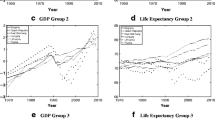Abstract
A new stochastic model for mortality rate is proposed and analyzed on Italian mortality data. The model is based on a stochastic differential equation derived from a generalization of the Milevesky and Promislow model (Milevesky, M.A., Promislow, S.D.: Insur. Math. Econ. 29, 299–318 (2001)). We discuss and present a methodology, based on the discretisation approach by Wymer (Wymer, C.R.: Econometrica 40(3), 565–577 (1972)) to evaluate the parameters of our model. The comparison with the Milevesky and Promislow model shows the relevance of our proposal along an horizon, which includes periods of time with a different volatility of mortality rates. The estimate of the parameters turns out to be stable over time with the exception of the mean reverting parameter, which shows, for a person of a fixed age, an increase over time.
Similar content being viewed by others
References
Milevesky, M.A., Promislow, S.D.: Mortality derivatives and the option to annuitise. Insur. Math. Econ. 29, 299–318 (2001)
Wymer, C.R.: Econometric estimation of stochastic differential equation systems. Econometrica 40(3), 565–577 (1972)
JPMorgan: LifeMetrics. A toolkit for measuring and managing longevity and mortality risks, V1.0 (2007)
Lee, R.D., Carter, L.R.: Modelling and forecasting U.S. mortality. J. Am. Stat. Assoc. 87, 659–671 (1992)
Lee, R.D.: The Lee-Carter method for forecasting mortality, with various extensions and applications. N. Am. Actuar. J. 4, 80–93 (2000)
Renshaw, A.E., Habermann, S.: A cohort-based extension to the Lee-Carter model for mortality reduction factors. Insur. Math. Econ. 38, 556–570 (2006)
Cairns, A.J.G.: A discussion of parameters and model uncertainty. Insur. Math. Econ. 27, 313–330 (2000)
Cairns, A.J.G., Blake, D., Dowd, K.: A two factor model for stochastic mortality with parameter uncertainty: theory and calibration. J. Risk Insur. 73, 687–718 (2006)
Currie, I.G.: Smoothing and forecasting mortality rates with P-splines. Available on line at www.ma.hw.ac.uk/iain/research/talks.html (2006)
Plat, R.: Stochastic portfolio specific mortality and the quantification of mortality basis risk. Available on line at http://ssrn.com/abstract=1277803 (2009)
Cairns, A.J.G., Blake, D., Dowd, K.: Pricing death: frameworks for the valuation and securitization of mortality risk, Centre for Risk & Insurance Studies. CRIS Discussion Paper Series, No. IV, The University of Nottingham (2006)
Biffis, E.: Affine processes for dynamic mortality and actuarial valuations. Insur. Math. Econ. 37, 443–468 (2005)
Ballotta, L., Habermann, S.: The fair valuation problem of guaranteed annuity options: the stochastic mortality environment case. Insur. Math. Econ. 38, 195–214 (2006)
Luciano, E., Vigna, E.: Non mean reverting affine processes for stochastic mortality. Belg. Actuar. Bull. 8(1), 5–16 (2008)
Gompertz, B.: On the nature of function expressive of the law of human mortality and on a new mode of determining the value of life contingencies. Philos. Trans. R. Soc. Lond. 123, 513–585 (1832)
Sargan, J.D.: Some discrete approximations to continuous time stochastic models. J. R. Stat. Soc. B 36, 74–90 (1975)
Seber, G.A.F., Wild, C.J.: Non linear regression. Wiley, New York (1989)
Biggs, M.C.: Constrained minimization using recursive quadratic programming. In: Dixon, L.C.W., Szegö, G.P. (eds.) Towards Global Optimization, pp. 341–349. North Holland, Amsterdam (1975)
Powell, M.J.D.: The convergence of variable metric methods for nonlinearly constrained optimization calculations. In: Mangasarian, O.L., Meyer, R.R., Robinson, S.M. (eds.) Non Linear Programming 3, pp. 27–63. Academic Press, New York (1978)
Powell, M.J.D.: A fast algorithm for nonlinearly constrained optimization calculations. In: Watson, G.A. (ed.) Numerical Analysis. Lecture Notes in Mathematics, vol. 630, pp. 144–157. Springer, Berlin (1978)
Ortobelli, S.: The classification of parametric choices under uncertainty: analysis of the portfolio choice problem. Theory Decis. 51, 297–327 (2001)
Author information
Authors and Affiliations
Corresponding author
Additional information
Communicated by F. Zirilli.
The authors greatly acknowledge the national grant from the Ministry of Education and Research: Financial innovations and demographic changes: new products and pricing instruments with respect to the stochastic factor aging (local coordinator M. Bertocchi) as well as grants from University of Bergamo 2008, 2009.
Rights and permissions
About this article
Cite this article
Giacometti, R., Ortobelli, S. & Bertocchi, M. A Stochastic Model for Mortality Rate on Italian Data. J Optim Theory Appl 149, 216–228 (2011). https://doi.org/10.1007/s10957-010-9771-5
Published:
Issue Date:
DOI: https://doi.org/10.1007/s10957-010-9771-5




